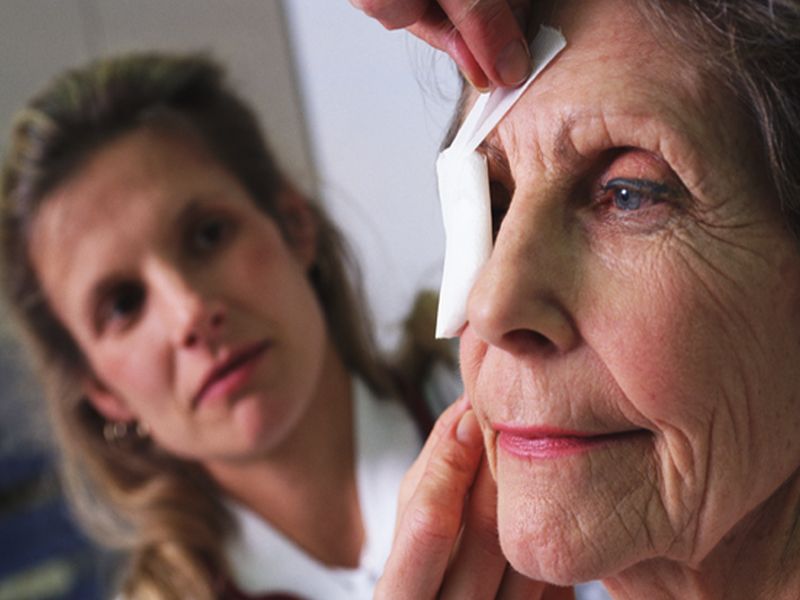Potentially Blinding Shingles of the Eye on the Rise
By Alan MozesHealthDay Reporter

THURSDAY, May 9, 2019 (HealthDay News) -- The virus that gave you chickenpox as a kid can rise again after decades of inactivity and inflict a painful, even blinding, eye infection in old age.
New research reveals that cases of eye-based "shingles" have tripled since 2004.
Exactly what is driving the increase remains unclear. What is clear, however, is that either of two vaccines could prevent many cases of shingles.
The problem? Relatively few Americans have been vaccinated.
"Shingles is a recurrence of pre-existing varicella zoster virus (VZV) infection, which patients likely first got when they had chickenpox earlier in life," said study lead author Dr. Nakul Shekhawat, an ophthalmologist with Kellogg Eye Center at the University of Michigan in Ann Arbor.
"VZV never completely goes away ... but lies 'dormant' in some of the deeper nerves of the body, and can reactivate years or even decades later within the territory of those same nerves to cause shingles," he explained.
In fact, roughly 20% of shingles cases strike nerves around the eye. Because the eye has "numerous highly sensitive nerves," it's particularly painful, Shekhawat said, and a rash, swelling, inflammation and pink eye can go along with it. In some cases, corneal scarring and blistering can result in permanent vision loss.
For their study, he and his colleagues analyzed health records for 21 million patients. They found that from 2004 to 2016, the rate of eye shingles infections rose from under 10 cases for every 100,000 people to more than 30 per 100,000.
Patients in the study were enrolled in the same healthcare plan, allowing investigators to compare treatment records over the 12-year period.
Although shingles infection rates did triple, the researchers found that those over age 75 were at highest risk. Among that population, there were 53 cases per 100,000, according to the study. Whites and women also had a higher risk.
Though shingles can strike younger adults, it is considered a peril of old age, Shekhawat said. Nationwide, it strikes about 4 in every 1,000 Americans -- but 10 in 1,000 of those over 60.
While Shekhawat said America's aging population is probably a factor, it's clear that "there's something else going on." What that might be is still unknown.
But getting more people vaccinated would likely make a big difference, he noted, adding: "From a public health and prevention standpoint, we can do much better."
A two-dose vaccine called Shingrix, approved in 2017, can prevent 97% of shingles cases, and an older vaccine (Zostavax) can cut risk by half.
What's more, even people who have had shingles can gain future protection by getting vaccinated, according to the U.S. Centers for Disease Control and Protection (CDC). It recommends Shingrix for anyone over 50.
Although vaccination patterns for Shingrix have yet to be analyzed, Shekhawat said only 10% to 30% of eligible patients have gotten the Zostavax vaccine.
Dr. Thomas Steinemann is a clinical spokesman for the American Academy of Ophthalmology.
He pointed out that the vaccine can't cure shingles or relieve symptoms once they develop, so people should plan to get the shot as a preventive measure, before problems begin.
Treatment can range from eye drops and compresses in manageable cases to surgery in more advanced cases, he said.
The researchers presented their findings last week at a meeting for the Association for Research in Vision and Ophthalmology in Vancouver. Research presented at meetings is typically considered preliminary until published in a peer-reviewed journal.
More information
To learn more about shingles, visit the U.S. National Institute of Neurological Disorders and Stroke.

The news stories provided in Health News and our Health-E News Newsletter are a service of the nationally syndicated HealthDay® news and information company. Stories refer to national trends and breaking health news, and are not necessarily indicative of or always supported by our facility and providers. This information is provided for informational and educational purposes only, and is not intended to be a substitute for medical advice, diagnosis, or treatment.

